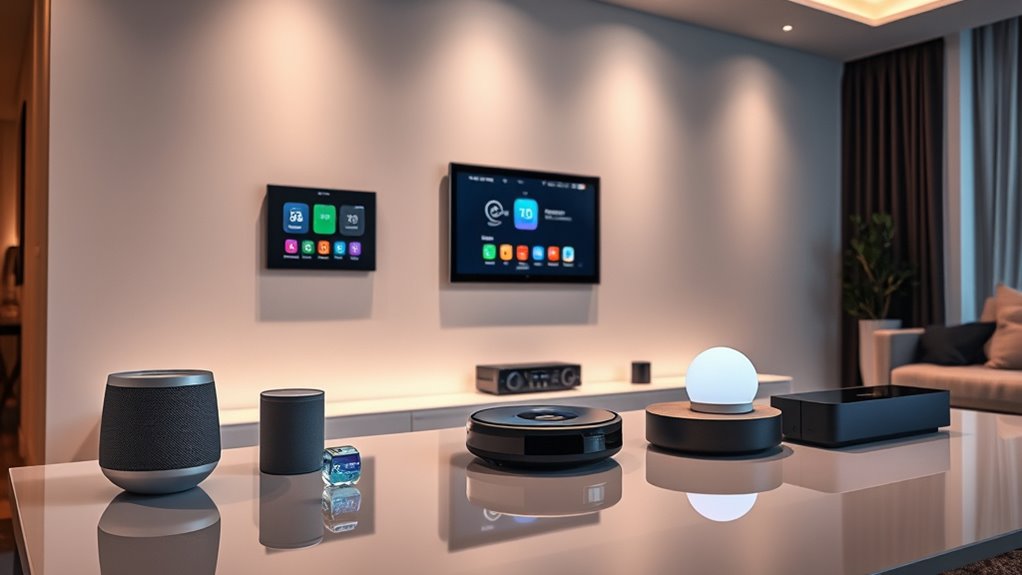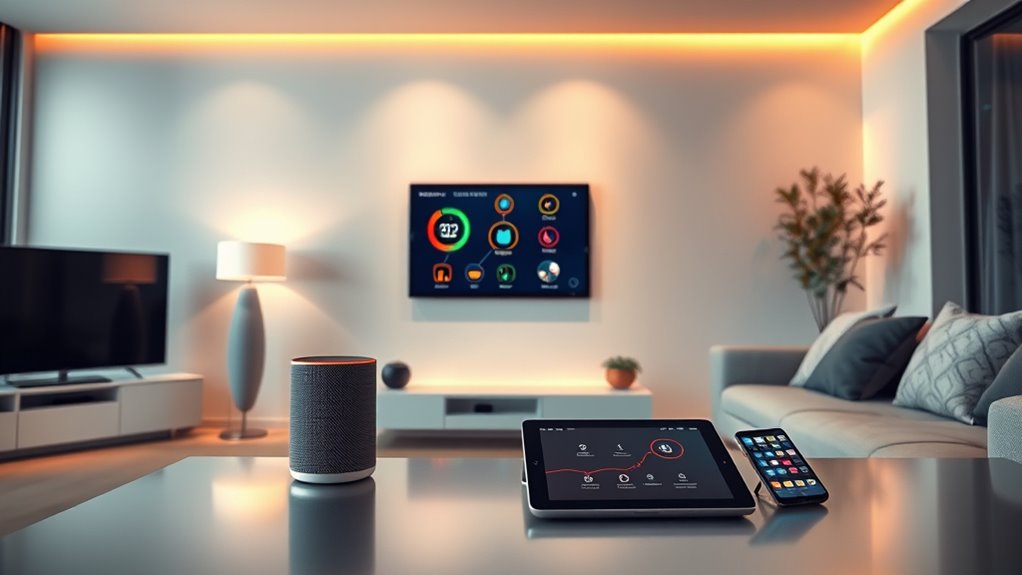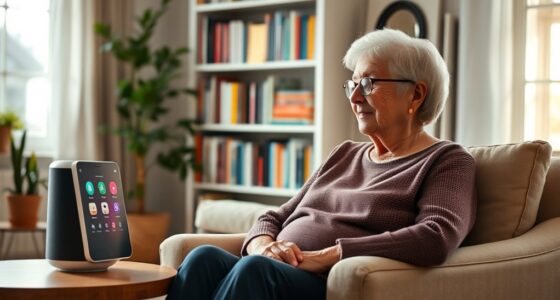To make all your smart devices work together smoothly, focus on choosing compatible products that support standards like Zigbee, Z-Wave, or Wi-Fi. Using a central hub or platform such as Alexa, Google Assistant, or Siri helps unify your system and simplifies voice commands. Ensuring compatibility reduces setup issues and improves reliability. By integrating devices seamlessly, you create a connected home that’s easier to control and more efficient—discover how to optimize your system for the best experience.
Key Takeaways
- Choose a central hub or platform like Amazon Alexa, Google Assistant, or Apple Siri to coordinate device control.
- Verify device compatibility with standards such as Zigbee, Z-Wave, or Wi-Fi to ensure seamless communication.
- Use compatible devices supporting standard protocols to enable simultaneous, synchronized actions via voice commands.
- Integrate devices through a unified ecosystem to simplify setup, troubleshooting, and future expansion.
- Leverage automation routines or scenes to enhance functionality and make all devices work together effortlessly.

Smart home integration has become increasingly essential as more devices and systems are designed to work together seamlessly. When you aim to create a connected living space, understanding how voice commands and device compatibility play vital roles is crucial. With the right setup, you can control multiple devices effortlessly, simply by speaking. Voice commands make daily routines more convenient, allowing you to turn on lights, adjust thermostats, or play music without lifting a finger. But for this to work smoothly, your devices need to be compatible with each other and the central hub or platform you choose. Device compatibility ensures that your smart gadgets can communicate effectively, avoiding frustration and technical issues.
Imagine walking into your living room and saying, “Dim the lights and play relaxing music.” If your smart lights and speaker system are compatible and integrated properly, your voice command triggers both actions simultaneously. This seamless experience hinges on selecting devices that can connect easily with one another. Not all smart devices are created equal, so you need to verify whether they support common standards like Zigbee, Z-Wave, or Wi-Fi, depending on your hub or ecosystem. When you choose compatible devices, you avoid the headache of dealing with incompatible products that may require additional hubs, apps, or configurations. This compatibility streamlines setup and guarantees your entire system functions as intended.
In addition to compatibility, voice commands rely heavily on the central voice assistant platform you opt for, such as Amazon Alexa, Google Assistant, or Apple Siri. These platforms serve as the brains of your smart home, translating your spoken requests into actions. To maximize efficiency, pick a platform that supports a broad range of devices and integrates well with your existing gadgets. When your devices are compatible with your chosen voice assistant, you can create routines or scenes that activate multiple devices with a single voice command. For example, saying “Good night” could turn off all lights, lock doors, and adjust the thermostat, making your bedtime routine effortless.
Ensuring that your devices support common standards like Zigbee, Z-Wave, or Wi-Fi can significantly enhance the device compatibility and overall functionality of your smart home system.
Frequently Asked Questions
How Secure Is Smart Home Device Integration From Hacking?
You might wonder how secure smart home device integration is from hacking. While these systems can enhance convenience, they pose cybersecurity risks if not properly protected. Manufacturers use encryption protocols to safeguard data, but vulnerabilities can still exist. To stay secure, confirm your devices have the latest firmware, use strong passwords, and enable two-factor authentication. Staying vigilant helps minimize risks and keeps your smart home safe from potential cyber threats.
Can I Control All Devices With a Single App?
You can control all your devices with a single app, simplifying your smart home experience. Many apps support voice commands and device automation, allowing you to manage everything effortlessly. By using one platform, you reduce the need to switch between multiple apps, making controlling your smart home more convenient and efficient. Just guarantee your devices are compatible with the app for seamless integration and smooth operation.
What Is the Best Platform for Multi-Brand Device Compatibility?
You want a platform that offers the best multi-brand device compatibility for seamless device automation. With a voice assistant like Amazon Alexa or Google Assistant, you can control various brands using a single app. These platforms support numerous devices, making automation easy. Choose one based on your preferred voice assistant, device compatibility, and features. This way, you guarantee smooth, integrated control over your smart home setup.
How Do I Troubleshoot Device Connectivity Issues?
Imagine your devices throwing a tantrum, refusing to connect like stubborn toddlers. To fix this, start with network troubleshooting—check your Wi-Fi signal and restart your router. If that doesn’t work, perform a device reset to clear any glitches. This simple act often solves stubborn connectivity issues, restoring harmony. Remember, patience is key; even devices need a timeout to get back in sync and work smoothly again.
Are There Privacy Concerns With Centralized Smart Home Systems?
You might wonder if centralized smart home systems pose privacy risks. They do collect data, which can be used for improving services, but also raises concerns about data collection and security breaches. You should be aware that your personal information could be accessed or misused if the system isn’t properly secured. To protect yourself, review privacy policies and choose systems with strong security measures, ensuring your data stays safe.
Conclusion
By integrating your smart devices, you create a seamless, efficient home that responds effortlessly to your needs. Imagine waking up and your curtains open, your coffee brews, and your security system arms itself—all automatically. Just like Sarah, who linked her lights, thermostat, and alarm system, now her mornings are smoother and more convenient. With smart home integration, you turn your house into a responsive, intelligent space that works for you, making everyday living simpler and more enjoyable.









